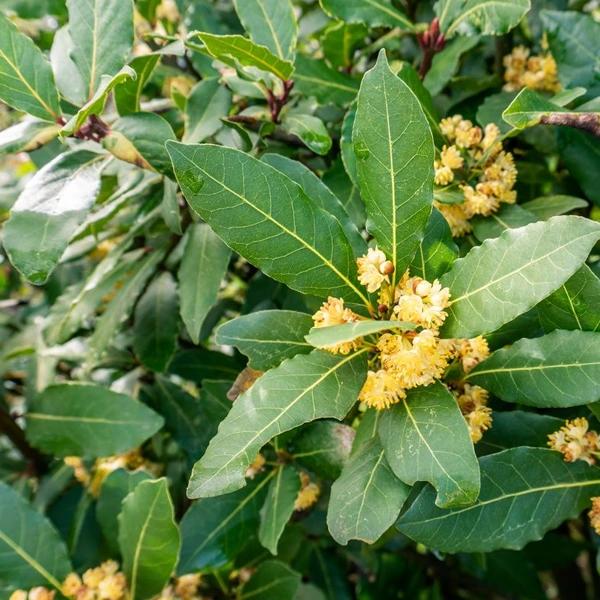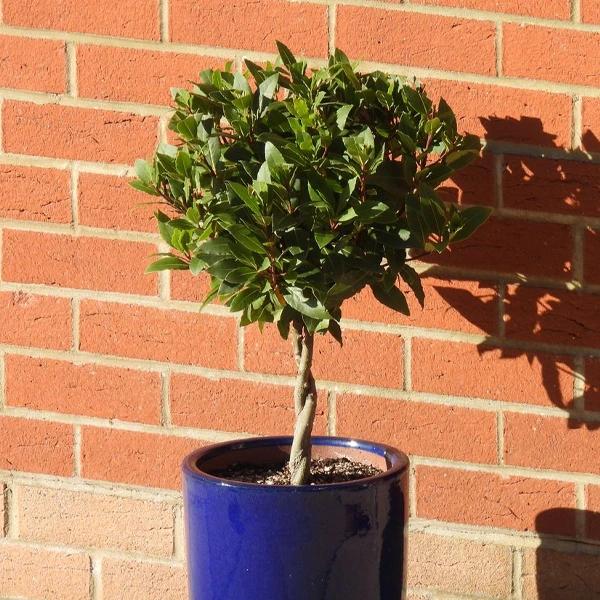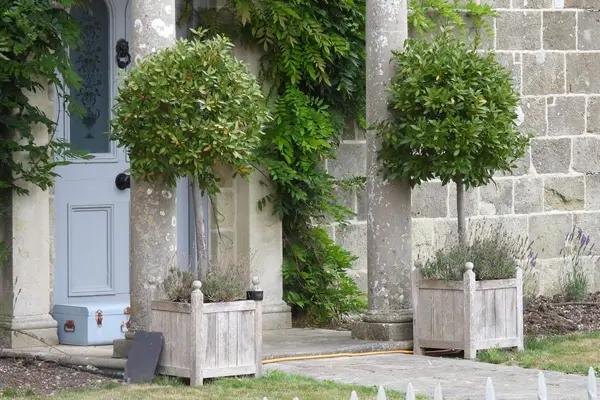Table of Contents
Laurus nobilis, Sweet Bay or Bay Laurel, is a smart evergreen tree, easy to clip as a hedge, ideal for training into topiary shapes.
The richly aromatic leaves are used in cooking to flavour stews and soups.
Our bay tree care guide has all the instructions you’ll need to care for your bay tree and get the best from it

Bay Tree Profile
Bay trees are native to the Mediterranean and are easy, undemanding trees to grow. Here are their key features:
- They are hardy down to about -5℃
- They should be grown in a sheltered spot in full sun or a partially shaded location
- They can be grown in any well-drained fertile soil
- They require only moderate watering
- Prune for shape in spring or summer, using secateurs
- Harder or regenerative pruning is best done in spring
- Feeding is best done during the growing season
- They can be grown in the ground or in containers
- They are available in many shapes and sizes; for example, twisted bay trees have stems that are trained in a single spiral, while double spirals combine two stems in a helix formation
- They are slow-growing but can reach heights of up to 8 metres. However, they respond well to pruning and are easy to keep at a manageable size

How & where to plant a bay tree
Choosing the right spot to plant your bay tree is important: bays like sun, and their leaves look best with shelter from strong wind. They grow in any well drained soil, and mature plants are drought tolerant.
Bay trees are well suited to growing in containers, a classic for placing around outdoor seated areas in summer, and moving to a sheltered spot for winter.
How to plant out a potted bay tree in the ground
Planting a bay tree in the ground is best for the tree, and it can grow very big:
- Dig a planting hole that is slightly larger than the plant’s root ball
- Improve the soil in the planting area by digging in some compost
Top tip: if the soil is heavy clay, do not dig anything in to improve it
- Sprinkle some mycorrhizal fungi on the bottom of the planting hole
- Tease a few roots loose from the root ball if they are circling around the bottom, or slice them in a couple of places if they are root bound.
- Place it in the planting hole upright (a bamboo cane in the planting hole can be helpful)
- Replace the soil in the planting hole and firm the soil around the rootball
- Cover the rootball with 1-2cm of the surrounding soil: do not leave the top of the rootball exposed, but don’t bury the stem of the plant
- Water well
Only established bay trees are drought tolerant; keep new trees watered regularly for the first year, then in very dry Summer weather for

Feeding your bay tree
Generally speaking, bay trees are not greedy, but bays in pots do need regular feeding throughout the Spring and Summer.
Use Rootgrow Afterplant or slow-release granules every couple of weeks in the growing season.
Repot container grown trees every couple of years in early spring; changing the soil will provide extra nutrients to help them flourish.
Watering your bay tree
Being native to the Mediterranean region, they do not require excessive watering. Still, you will need to water young bay trees regularly during the first year of growth until they are fully established. Water thoroughly every couple of weeks; you can check if you need to water by digging a small hole near the tree to see if the soil is dry. The care of bay trees in pots is slightly more demanding in that container grown bay trees need to be watered more often, every two days or so in the summer. They hate being waterlogged, however, so avoid overwatering and do not let the roots stand in water.
How and when to prune a bay tree
The best time to trim a bay tree is in Spring and Summer when it’s in growth; regular clipping will encourage bushy growth and maintain a tidy shape.
VIDEO TRANSCRIPT
But you can prune anytime of year, perhaps avoiding the extremes of peak summer heat and winter freeze.
- Use sharp secateurs on single bay trees for a great finish
- Make your pruning cuts between leaf nodes, avoid cutting through leaves
- Prune new shoots to a bud facing in a good the direction: up and out
- In spring, after the last frost, prune off yellow or brown stems and leaves.
Mature bay trees can be hard pruned in early spring (renovation pruning). This is usually done over two or three seasons to avoid shocking the tree.
Harvesting bay leaves
Harvest bay leaves for home cooking by hand, year round.
Used fresh or dried, the dark green leaves of Sweet Bay are a versatile addition to the spice rack, adding a delicious peppery warmth to savoury dishes as well as also being used to accent mulled wine and sweet dishes like rice pudding.
Along with parsley and thyme, bay leaves are an essential component in bouquet garni, the traditional bundle of herbs used in French cuisine.
How to protect a bay tree in winter
Although bay trees are hardy in the UK, they can suffer cosmetic damage from frost and cold winds. Bay trees in pots tend to be more sensitive than those in the ground
Bay tree winter care tips:
- Plant bay trees in sheltered locations in the first place
- Move smaller pot grown bay trees to shelter: a frost free but unheated greenhouse or garage with windows is good
- Use horticultural fleece or bubble wrap to protect young or exposed container grown bay trees over the winter
Is tomato feed good for bay trees?
Tomato food is fine to help pot grown bay trees that are malnourished, but your regular fertiliser should be Rootgrow Afterplant, or slow release fertiliser granules.
Don’t feed bay trees during winter.
Brown or yellow leaves on your bay tree?
If your bay is looking sick with browning or yellowing leaves, use our Bay Tree Problems & Solutions checklist to diagnose the cause.
Key Takeaway
Bay responds well to regular trimming, wants well drained soil with plenty of sun, and potted plants might be worth protecting with fleece in mid-Winter.
